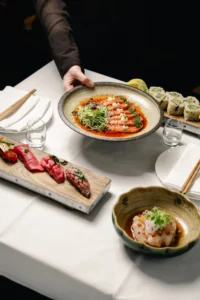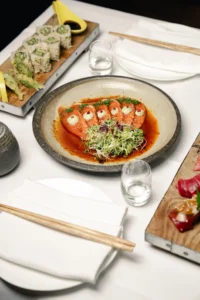Japanese Dining Hospitality: The Spirit of Omotenashi
Japanese dining hospitality goes beyond food, embracing omotenashi, the timeless spirit of care, respect, and selfless anticipation. This invisible yet powerful force shapes every meal, whether in a family home, a casual eatery, or a Michelin-starred restaurant. Omotenashi is not simply about service. It is about anticipating needs before they are spoken, creating comfort, and showing respect in the smallest gestures.
Understanding Japanese Dining Hospitality
 Omotenashi is a cultural philosophy deeply rooted in Japanese life. Unlike service focused on transactions, it places empathy at the centre. Hosts anticipate needs rather than wait to be asked. They provide more than efficiency; they create warmth.
Omotenashi is a cultural philosophy deeply rooted in Japanese life. Unlike service focused on transactions, it places empathy at the centre. Hosts anticipate needs rather than wait to be asked. They provide more than efficiency; they create warmth.
Moreover, omotenashi is not about gaining rewards or recognition. It is about offering kindness with sincerity. This attitude influences how meals are prepared, served, and enjoyed across Japan.
Everyday Omotenashi at the Table
The Role of Small Gestures
Even in everyday meals, omotenashi is clear. A mother carefully places chopsticks in the correct direction. A host pours tea before guests notice their cups are empty. Such gestures seem small. Yet, they carry deep meaning. They say, “You are cared for.”
Meals That Honour the Seasons
Furthermore, home cooking often reflects the seasons. Hosts choose vegetables, fish, or fruits that celebrate nature’s cycle. Seasonal dishes show thoughtfulness, connecting guests with both food and the natural world.
Japanese Dining Hospitality in Tradition
Kaiseki: The Height of Refinement
Nowhere is omotenashi more visible than in kaiseki dining. This multi-course meal showcases balance, artistry, and care. Every dish is chosen to please not only the palate but also the eye and spirit.
Chefs plan menus around the time of year. They present dishes on plates that match the season’s mood. Servers explain dishes with grace, making diners feel part of a shared story.
The Tea Ceremony’s Silent Care
Similarly, the Japanese tea ceremony embodies omotenashi. The host prepares each movement with precision and mindfulness. Every bow, every turn of a bowl, expresses respect. Silence creates space for appreciation. Nothing feels rushed, and nothing feels left to chance.
Omotenashi in Modern Restaurants
Casual Dining with Heart
 Even in ramen shops or sushi counters, omotenashi thrives. Staff greet customers with lively “Irasshaimase!” (welcome). They notice when a diner struggles with the menu. They suggest popular dishes or adjust spice levels. These actions build trust and ease.
Even in ramen shops or sushi counters, omotenashi thrives. Staff greet customers with lively “Irasshaimase!” (welcome). They notice when a diner struggles with the menu. They suggest popular dishes or adjust spice levels. These actions build trust and ease.
Fine Dining on a Global Stage
Japanese chefs abroad also carry omotenashi with them. Whether in London, Paris, or New York, they uphold its principles. Guests feel the same care as in Japan. The food may adapt to local tastes, yet the hospitality remains unchanged.
Why Japanese Dining Hospitality Matters Today
Omotenashi offers lessons for modern life. In fast-paced cities, meals often become rushed and impersonal. Yet, this philosophy reminds us that dining is a shared human moment. It is a chance to slow down and connect.
Moreover, businesses worldwide now look to omotenashi as a model. Airlines, hotels, and retailers study how to anticipate needs before customers voice them. They see its power to build loyalty and trust.
Bringing Omotenashi Home
You do not need to travel to Japan; instead, you can embrace omotenashi at home. Moreover, anyone can practise it at their own table. First, start by paying attention to details. Then, notice what guests might need. Afterwards, offer comfort without waiting for requests. Furthermore, use seasonal food to make meals special. Most importantly, always act with sincerity.
Conclusion: The Lasting Spirit of Omotenashi
Omotenashi is more than good manners. It is a way of life that honours respect, empathy, and thoughtfulness. In Japanese dining culture, it transforms meals into memorable experiences. From a simple bowl of miso soup to a lavish kaiseki banquet, omotenashi ensures every guest feels seen and valued.
By embracing this spirit, we can all shape dining moments that go beyond taste. We can create meals that nourish not only the body but also the heart.



